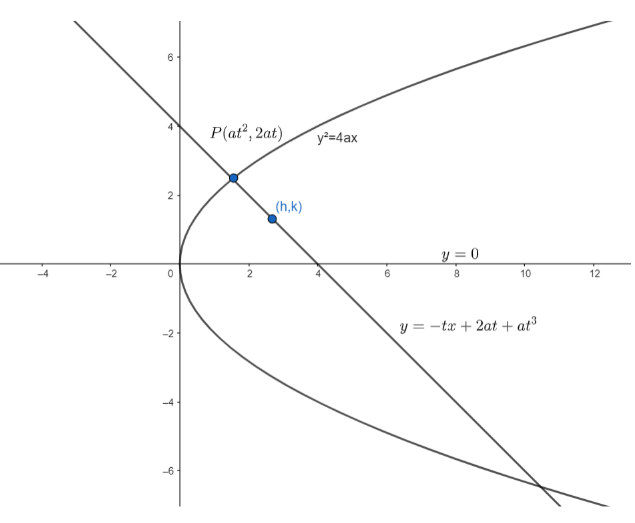Question
Question: Prove that the locus of the middle point of a portion of a normal intersected between the curve and ...
Prove that the locus of the middle point of a portion of a normal intersected between the curve and the axis is a parabola whose vertex is the focus and whose latus rectum is one quarter of the original parabola.
Solution
Hint: The equation of normal in parametric form is given as y=−tx+2at+at3, where the normal is drawn at a point P with parameter t.
First of all , let’s take the equation of the parabola to be y2=4ax.

Coordinates of any point on the parabola in parametric form is given as P(at2,2at).
We know, equation of normal in parametric form , where the normal is drawn at a point P with parameter t, is given as
y=−tx+2at+at3....(i)
Also, the equation of axis of the parabola is
y=0.....(ii)
To find the points of intersection of (i)and(ii), we substitute y=0 in (i).
So, 0=−tx+2at+t3
⇒x=2a+at2
So , the point of intersection of the axis and the normal is (2a+at2,0).
Now , let the midpoint of intercepted portion be (h,k).....(iii)
But we also know that the extremities of the intercepted portion are (at2,2at) and (2a+at2,0).
Now, we know that the coordinates of the midpoint of the line joining two points (x1,y1) and (x2,y2) is given as: (2x1+x2,2y1+y2)
So, the coordinates of the midpoint are
(2at2+2a+at2,22at+0)
=(at2+a,at)...(iv)
So, from (iii)and (iv), we can say
h=at2+a....(v), k=at
Now, k=at$$$$\Rightarrow t=\dfrac{k}{a}...\left( vi \right)
Substituting t=akin (v), we get
h=a(ak)2+a
⇒h=ak2+a
⇒k2=ah−a2........ equation(vii)
Now , to get the equation of the locus of (h,k), we will substitute (x,y) in place of (h,k) in equation(vii).
Or, y2=a(x−a)....(viii) is the equation of the locus.
Now , we know the length of the latus rectum of y2=4ax is 4a.
Now , the length of latus rectum of parabola given by equation (vii)is 4×4a=a
Also, the vertex of (viii) is (a,0) which is the focus of y2=4ax
Hence , the length of the latus rectum of the locus is one quarter of the original parabola and the vertex of the locus is the focus of the original parabola .
Note: Length of latus rectum of parabola y2=4ax is equal to 4a and not a.
Focus of parabola y2=4ax is (a,0) and not (4a,0).
Students generally get confused and make mistakes which results in wrong answers. So , such mistakes should be avoided .
